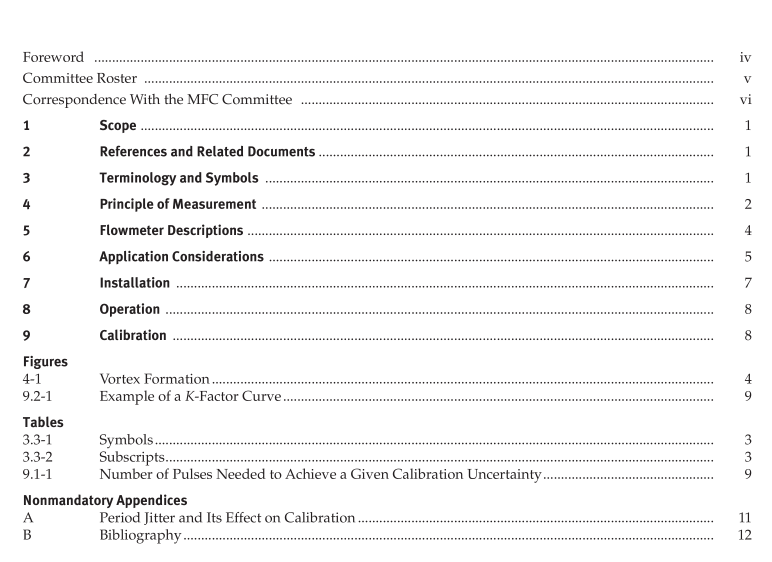ASME MFC-6:2013 pdf free download Measurement of Fluid Flow in Pipes Using Vortex Flowmeters
5.1.2.2 Digital Transmitters.Digital transmittersuse one or more microprocessors to process raw inputsignals and provide output signals and a user interface.These transmitters are often referred to as smart trans-mitters. Their use of microprocessors provides severaladvantages over analog transmitters. Because the inputsignals are processed digitally,these transmitters cananalyze the signals using mathematical algorithms todetermine installation quality, external interference, andnoise. Based on this analysis, the transmitters may beable to digitally filter out spurious signals.The use ofmicroprocessors and digitai processing minimizes theeffect of component drift that may occur in analog trans-mitters. Digital transmitters may also be able to compen-sate for changes in the meter K factor caused by changesin process temperature and pressure.
Typical human interface is via a digital numeric orgraphical display and buttons and optical or magneticsensors to program parameters, or via a handheld com-municator.Digital transmitters are programmable forrange and other parameters in user-selectable units andlanguages. This configuration is stored on the transmitterand may also be uploaded via the communication pro-tocol to other devices.
Digital transmitters may also include the ability toprogram a low-flow cutoff below which the instrumenteither emits an error signal or holds the output to zero.Alternatively, at no-flow conditions, the digital transmit-ter may determine the low-flow cutoff by differentiatingbetween signal and noise, and adjust the measurementthreshold accordingly.
Digital transmitters may be enabled with protocolsthat allow communication with other compatible instru-ments, communication devices,and control systemssuch as distributed control systems (DCS). Most digitaltransmitters include a programmable output range of4 mA to 20 mA unless precluded by a communicationprotocol. They are also likely to include a programmablepulse or frequency output range.
5.1.2.3 Multivariable Transmitters.Multivariabletransmitters are digital transmitters equipped with mul-tiple inputs to the electronics to provide the temperatureand pressure of the fluid that the meter is measuring.Multivariable transmitters perform a larger number ofcalculations than do typical digital transmitters. Vortexshedding flowmeters measure the volumetric flow rate.In many applications,the mass flow rate of the fluid isof interest.To calculate the mass flow rate from a vortexshedding meter’s volumetric flow reading, the flowingdensity of the fluid must be determined.The flowing den-sity can be calculated from the flowing temperature, pres-sure, and an equation of state for the specific fluid.Thereare exceptions to these requirements, and in the case of aliquid, the pressure effect is typically minimal and can beneglected.In the case of saturated steam, the density canbe determined from knowledge of either the pressure or temperature; however, if the steam is superheated, thenboth pressure and temperature are required.
Multivariable transmitters may have built-in temper-ature and pressure sensors or may accept temperature-and,if required, pressure-measurement signals fromexternal sensors.
The configuration of a multivariable transmitter is simi-lar to that described for digital transmitters, but it requiresadditional steps to provide an accurate output. The inputsfrom the temperature and pressure sensors must be con-figured in the multivariable transmitter’s electronics.Thecorrect process fluid or equation of state must be selectedin the electronics, and potentially more than one 4-mA to20-mA output or other, digital output must be configured.It is extremely important that the right selection is madefor the density compensation calculation.
The multivariable transmitter provides the tempera-ture and, if applicable, pressure measurements to theend user via either a digital communications protocolor multiple 4-mA to 20-mA outputs.In addition, sincethe multivariable transmitter computes the density ofthe fluid, it can provide this value as well as a numberof other computed fluid parameters to the user. Consultthe manufacturer’s literature to determine what vari-ables the multivariable transmitter can calculate.The Kfactor is a nonlinear function of the Reynolds number(see Fig. 9.2-1), and the multivariable transmitter cancompute the Reynolds number and correct the nonline-arity in the K factor. The flowing density of the fluid canbe used to predict the expected strength of the vorticesat a specific flow rate, allowing more accurate filteringalgorithms in the transmitter to address signal interfer-ences at low-flow rates.
5.2Equipment Markings
Meters shall be marked by the manufacturer to identifythe manufacturer, serial number, pressure rating, mean Kfactor, or meter factor, and hazardous location certifica-tion, if any.The direction of flow shall be permanentlyindicated by the manufacturer on the meter body.
6APPLICATION CONSIDERATIONS
There are several considerations related to applicationof vortex meters,but the three primary ones are sizing,process influences, and safety.
6.1 Sizing
Size the meter according to the desired flow rangerather than the nominal pipe size.The flowmeter sizeshall be selected such that the expected process flow ratefalls between the maximum and minimum flow rateswithin the required uncertainty.
ASME MFC-6:2013 pdf free download
